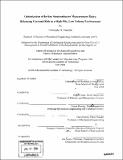Optimization of in-line semiconductor measurement rates : balancing cost and risk in a high mix, low volume environment
Author(s)
Pandolfo, Christopher R. (Christopher Robert), 1975-
DownloadFull printable version (10.33Mb)
Other Contributors
Leaders for Manufacturing Program.
Advisor
Roy E. Welsch and Duane Boning.
Terms of use
Metadata
Show full item recordAbstract
Due to a number of market development over the last decade, semiconductor manufacturing companies, including Intel Corporation, have added significant numbers of primarily high growth rate, high-mix, low-volume (HMLV) products to their portfolios. The rapid transition from high-volume manufacturing (HVM) to HMLV manufacturing has caused significant problems. Foremost, the needs of many HMLV customers are different from HVM customers and require different operational tradeoffs. Moreover, many of the HVM focused metrics, tools, systems and processes have proven ill-suited for managing the added complexities and more varied needs of HMLV customers. This thesis examines many of the problems caused by introducing HMLV products into an HVM wafer fabrication facility (commonly referred to as a fab), and explores potential solutions such as improved cultural and organizational alignment; capacity management and setup elimination; and scheduling and work-in-process management to name a few. Although the discussion focuses on semiconductor operations, the concepts easily generalize to other companies struggling with achieving operational excellence (OpX) in an HMLV environment. In addition to exploring the macroscopic HMLV issues, we also feature an in-depth analysis of one aspect of achieving OpX in the HMLV environment: the optimization of in-line metrology skip rates. Based on a review of the current methods, a new approach is suggested based on a Bayesian economic skip-lot model we call MOST/2. In general, MOST/2 suggests that significant cost savings can be realized with only modest increases in the material at risk per excursion if measurement rates are further reduced. Compared with the other methods analyzed, the data indicates that MOST/2 (cont.) provides superior cost/risk balanced results. For the 27 operations analyzed, results include annual costs savings of over $95,000, cycle time savings of over 5.3 hours per lot, operator savings of over 4.2 people per year and metrology capacity utilization rate reductions of over 65%. Finally, a brief organizational study was conducted to identify political, cultural and strategic design changes that would bolster long-term operational excellence (OpX) in the HMLV environment. Suggested changes include better identification of customer needs, improved communication and linking between groups, modification and alignment of factory and performance metrics and the creation of a stand-alone HMLV organization.
Description
Thesis (M.B.A.)--Massachusetts Institute of Technology, Sloan School of Management; and, (S.M.)--Massachusetts Institute of Technology, Dept. of Mechanical Engineering; in conjunction with the Leaders for Manufacturing Program at MIT, 2004. Includes bibliographical references (p. 99-101).
Date issued
2004Department
Leaders for Manufacturing Program at MIT; Massachusetts Institute of Technology. Department of Mechanical Engineering; Sloan School of ManagementPublisher
Massachusetts Institute of Technology
Keywords
Sloan School of Management., Mechanical Engineering., Leaders for Manufacturing Program.